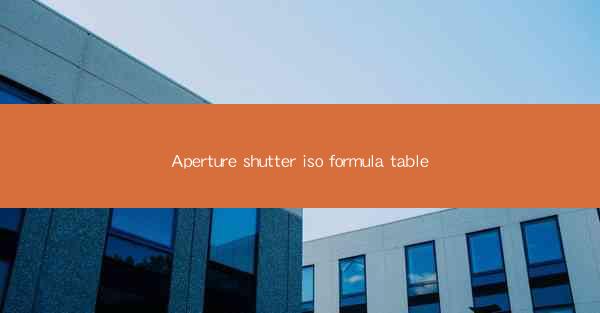
Aperture, Shutter Speed, ISO: The Formula Table for Photography
Photography is an art form that requires a deep understanding of various technical aspects to capture the perfect shot. Among these, Aperture, Shutter Speed, and ISO are the three primary components that determine the exposure of an image. This article aims to provide a comprehensive guide to understanding the Aperture, Shutter Speed, ISO formula table and its implications in photography.
Understanding Aperture
Aperture is the opening in the lens that controls the amount of light entering the camera. It is represented by a f-number, which is inversely proportional to the size of the aperture. A smaller f-number indicates a larger aperture, allowing more light to enter the camera, while a larger f-number indicates a smaller aperture, allowing less light to enter.
How Aperture Affects Depth of Field
One of the most significant effects of aperture is the depth of field. Depth of field refers to the distance between the nearest and farthest objects in a scene that appear acceptably sharp in an image. A larger aperture (smaller f-number) results in a shallower depth of field, making the subject stand out against a blurred background. Conversely, a smaller aperture (larger f-number) results in a deeper depth of field, ensuring that more of the scene is in focus.
Aperture and Low Light Conditions
In low light conditions, a larger aperture is beneficial as it allows more light to enter the camera. This helps in achieving a proper exposure without increasing the shutter speed or ISO, which could potentially introduce motion blur or noise, respectively.
Aperture and bokeh
Bokeh refers to the aesthetic quality of the out-of-focus areas of an image. A larger aperture can create a more pronounced bokeh effect, which is often desired in portrait photography to isolate the subject from the background.
Exploring Shutter Speed
Shutter speed is the duration for which the camera's shutter remains open, allowing light to reach the sensor. It is measured in seconds or fractions of a second. A faster shutter speed (e.g., 1/1000 sec) allows less light to enter the camera, while a slower shutter speed (e.g., 1/15 sec) allows more light to enter.
How Shutter Speed Affects Motion Blur
Shutter speed plays a crucial role in capturing motion. A fast shutter speed can freeze motion, making fast-moving subjects appear sharp. Conversely, a slow shutter speed can blur motion, creating a sense of motion or conveying the essence of a moving subject.
Shutter Speed and Low Light Conditions
In low light conditions, a slower shutter speed allows more light to enter the camera. However, this can lead to motion blur if the camera is not stable. Using a tripod or employing image stabilization techniques can help mitigate this issue.
Shutter Speed and Long Exposure
Long exposure photography involves using a slow shutter speed to capture scenes with moving elements, such as light trails or flowing water. This technique can create surreal effects and add a sense of time to the image.
ISO: The Sensitivity Factor
ISO is a measure of the camera sensor's sensitivity to light. A higher ISO value indicates a more sensitive sensor, allowing the camera to capture images in low light conditions with less noise. Conversely, a lower ISO value indicates a less sensitive sensor, resulting in cleaner images with less noise.
ISO and Low Light Conditions
In low light conditions, increasing the ISO can help achieve a proper exposure without increasing the aperture or shutter speed. However, higher ISO values can introduce noise, which can degrade image quality. Finding the right balance between ISO, aperture, and shutter speed is crucial in low light photography.
ISO and High Sensitivity Sensors
Modern cameras often feature high sensitivity sensors, which can handle higher ISO values without significant noise. This allows photographers to capture images in challenging lighting conditions with minimal noise.
ISO and Dynamic Range
ISO also affects the dynamic range of an image. A higher ISO value can compress the dynamic range, making it more challenging to capture scenes with both bright and dark areas. Conversely, a lower ISO value can help maintain a wider dynamic range, allowing for more detail in both highlights and shadows.
The Aperture, Shutter Speed, ISO Formula Table
The Aperture, Shutter Speed, ISO formula table is a useful tool for understanding the relationship between these three components. The formula is as follows:
```
Aperture x Shutter Speed = ISO
```
This formula can be rearranged to find any of the three variables when the other two are known.
Using the Formula Table for Exposure Control
The formula table can be used to control exposure by adjusting one or more of the variables. For example, if you want to increase the exposure, you can either increase the aperture, decrease the shutter speed, or decrease the ISO. Conversely, if you want to decrease the exposure, you can decrease the aperture, increase the shutter speed, or increase the ISO.
Limitations of the Formula Table
While the Aperture, Shutter Speed, ISO formula table is a useful tool, it has limitations. It assumes that the scene is well-lit and that the camera's metering system is accurate. In challenging lighting conditions or when using flash, the formula may not be as effective.
Conclusion
Understanding the Aperture, Shutter Speed, ISO formula table is essential for photographers looking to master the art of exposure. By mastering these three components, photographers can capture images with the desired level of exposure, depth of field, and motion blur. Experimenting with different combinations of aperture, shutter speed, and ISO will help you develop a unique style and vision in your photography.











